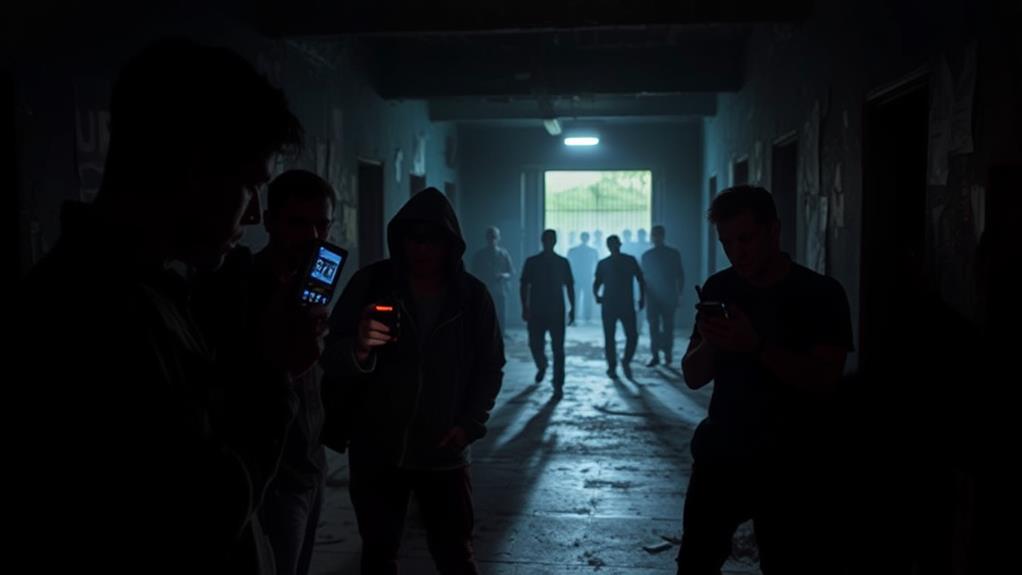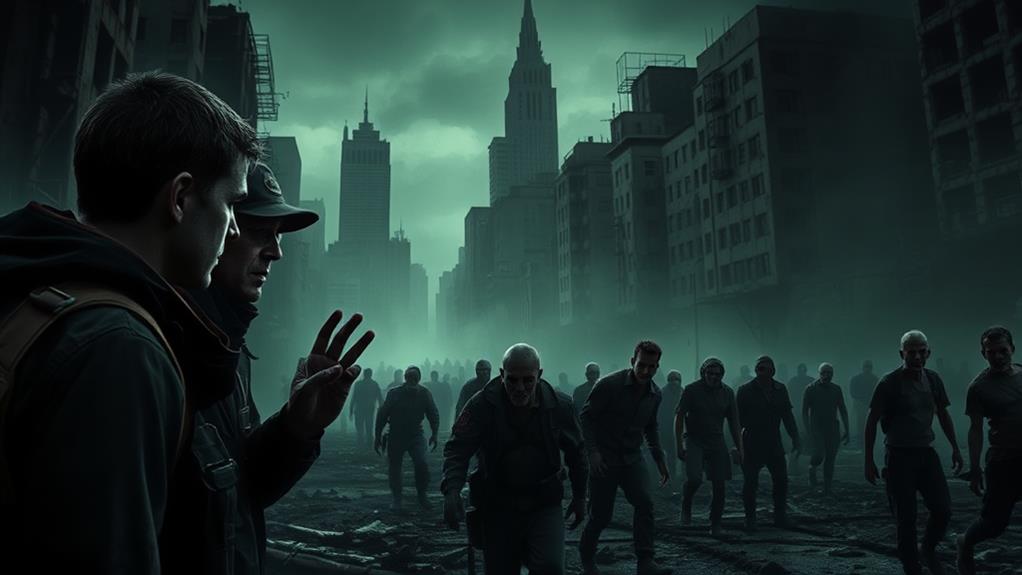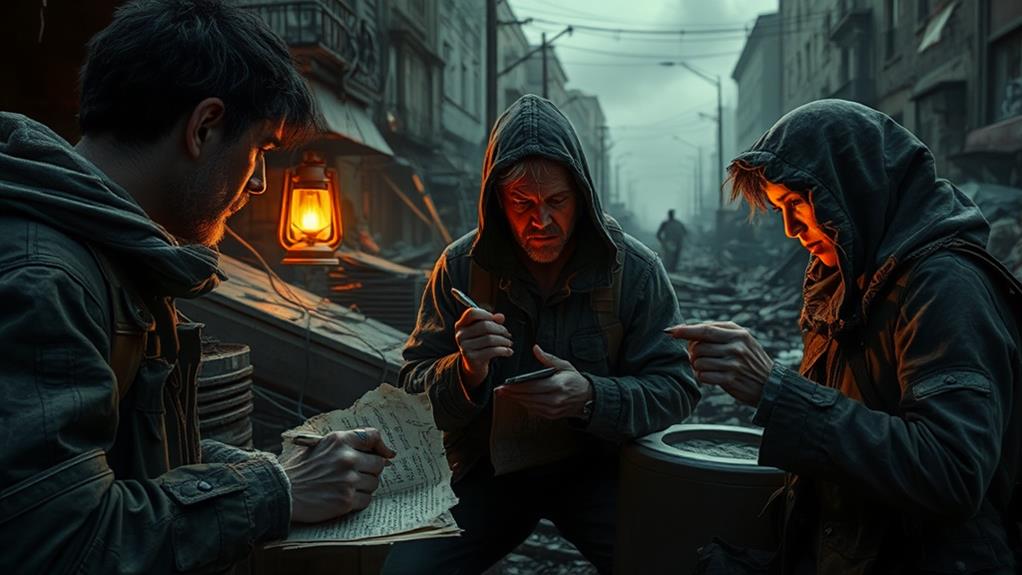
You need reliable and silent communication methods to increase your chances of survival during a zombie outbreak. Master hand signals to quickly convey messages without making noise. Flashlight codes can keep your group coordinated even at night. Use written notes for precise instructions or warnings. Learning Morse Code adds a versatile, discreet way to communicate over distances. Finally, color-coded flags provide a visual signaling system when sounds might attract unwanted attention. Each method offers unique advantages that can save your life if you prepare effectively. Discover more to fully equip your survival arsenal.
Hand Signals

Hand signals, often utilized for silent communication, play a critical role in various fields where verbal communication isn't feasible. In a zombie outbreak scenario, you need to communicate with your group without making noise that could attract the undead. Knowing a set of hand signals can save lives and guarantee your team moves efficiently.
First, establish a basic set of signals with your group. Simple gestures like pointing to your eyes to signal "look," a flat hand moved downward to mean "stop," and a closed fist to indicate "danger" can be very effective. Make sure everyone understands these signals clearly to avoid confusion.
In addition to basic commands, develop more complex signals for specific situations. For example, using two fingers to mimic walking can indicate "move quietly," while a circular motion with your hand can mean "regroup." Practice these signals regularly to guarantee everyone is on the same page.
Hand signals allow you to maintain coordination and remain undetected. They're quick, silent, and don't rely on any equipment. In a dire situation like a zombie outbreak, mastering hand signals could be the difference between life and death.
Flashlight Codes
In the stillness of night, flashlight codes become invaluable for silent communication. When zombies are lurking, you need a way to relay messages without making a sound. Flashlight codes provide a discreet and effective solution, allowing you to communicate over distances while staying hidden.
Four essential flashlight codes you should know:
- One Flash: Use this to signal "Yes" or "I understand." It's a quick and easy way to confirm a message without drawing too much attention.
- Two Flashes: This means "No" or "Negative." It's equally straightforward and helps keep your communication clear and concise.
- Three Flashes: This indicates "Danger" or "Proceed with Caution." When you see three rapid flashes, it's a clear sign that you need to be on high alert.
- Four Flashes: This stands for "Come to me." Use this code when you need someone to move to your location. It's direct and effective for coordinating group movements.
Mastering these basic flashlight codes can save your life during a zombie outbreak. Remember to practice them regularly with your group to guarantee everyone is on the same page.
Written Notes

Relying on written notes is a practical and silent way to communicate crucial information during a zombie apocalypse. You can use them to coordinate movements, share warnings, or convey instructions without making noise that could attract unwanted attention. Keep a small notebook and a pen handy at all times. It's essential for quick, on-the-spot communication.
When writing notes, be concise and clear. Use short sentences and bullet points to guarantee the message is easily understood. For example, "Zombies near east gate. Avoid area." This approach minimizes any chance of misinterpretation. Also, use symbols or drawings if they can convey the message more effectively.
Make sure to establish a common understanding of specific shorthand or symbols within your group. For instance, a simple "X" could mean danger or a circle could indicate a safe spot. This pre-established code helps speed up communication and reduces the risk of confusion.
Morse Code
Mastering Morse Code can be a lifesaver in a zombie apocalypse. This age-old system of dots and dashes can help you communicate silently over long distances without attracting unwanted attention. Whether you're using a flashlight, tapping on a surface, or signaling with a whistle, Morse Code's versatility is unmatched.
Here's why you should consider adding Morse Code to your survival toolkit:
- Stealth: Unlike talking, Morse Code signals are discreet and can be easily camouflaged with environmental noises.
- Distance: You can send Morse Code over longer distances using light or sound, which is vital when you're separated from your group.
- Reliability: Morse Code doesn't rely on batteries or electronics, making it dependable when modern technology fails.
- Ease of Learning: Basic Morse Code can be learned quickly, allowing everyone in your group to become proficient in a short amount of time.
Morse Code can be your secret weapon, enabling you to coordinate movements, warn of dangers, or simply stay connected with allies. By taking the time to practice and master this skill, you'll gain a powerful tool to outsmart the undead and guarantee your survival.
Color-coded Flags

While Morse Code offers a versatile way to communicate silently, color-coded flags provide another effective method for signaling in a zombie apocalypse. You can create a system that everyone in your group understands, guaranteeing quick and clear communication without making a sound.
First, gather brightly colored fabric or material that can be easily seen from a distance. Assign each color a specific meaning. For example, red flags might indicate immediate danger or the presence of zombies, while green flags could signal a safe zone or all-clear. Yellow flags could be used for caution, and blue might indicate the need for assistance or supplies.
Next, establish a set of rules for how to display these flags. A single flag could convey a basic message, while combinations or patterns can provide more detailed information. For instance, a red flag followed by a yellow one might mean zombies are near, but the path is still passable with caution.
Make sure everyone in your group knows the meanings and rules. Practice regularly so that when the time comes, you can communicate quickly and effectively. This method certifies you stay silent, yet informed, during critical moments.
At a Glance
In the event of a less-than-lively situation, staying quiet is key. Hand signals, flashlight codes, written notes, Morse code, and color-coded flags will keep you out of harm's way. These silent communication methods are your best bet for staying off the menu. Remember, it's all about staying one step ahead and keeping your presence under wraps. Stay sharp, stay safe, and keep your communication under the radar. You'll navigate this tricky terrain just fine.






